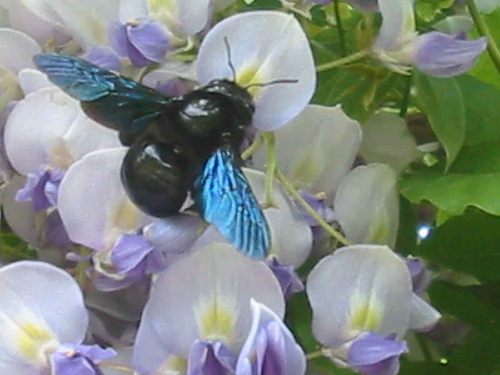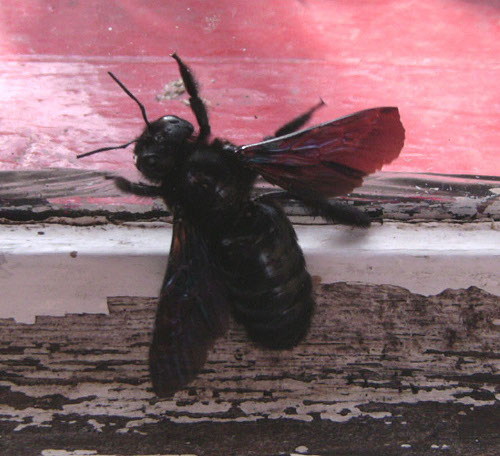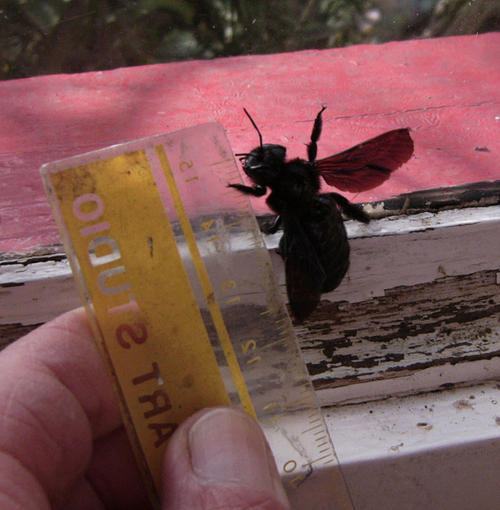The Violet Carpenter Bee Xylocopa violacea in Worcestershire 2010
Harry Green
Readers of the Bees & Wasps section of Wildlife Reports in British Wildlife may have noticed a series of reports of Violet Carpenter Bees occurring in England and occasionally nesting and overwintering successfully (see Baldock 2009, 2010, & http://www.bwars.com/xylocopa_violacea.htm). We have been on the lookout in Worcestershire for this spectacular bee for several years. This year (2010) two sightings were reported, one through the Worcestershire Wildlife Trust web site, the other through an email enquiry to the Trust In both instances the observers had taken confirmatory photographs with mobile phones.
The first report came from the west of the county at the beginning of June. Nick Emms wrote “Please find attached a photo of what I believe to be a black wasp feeding on our Wisteria in Lower Frith Common. I’ve never come across one of these before and wonder whether you can tell me if they are indigenous and how common. As an indication of size the flower petal is 20mm across its widest part”. The picture showed a fine Violet Carpenter bee!
The second report was at Welland in the south of the county on both the 6th and 27th October.2010. The photographs taken on the 27th October appear below.
A third possible sighting near Evesham early in summer could not be confirmed.
The Violet Carpenter Bee Xylocopa violacea has been spreading northward in Europe for some years reaching the north coasts of France and Belgium and the sightings in England may be of immigrants that have crossed the channel. It is also the possible they have been imported in timber or timber products. A second species Xylocopa valga is very similar in appearance and has a more southerly distribution in Europe but there have been occasional northerly records. The males of the species are easily identified as two segments (11 and 12) of the antennae near the tip are red in X. violacea and black in X. valga. The females are more difficult to tell apart by looking at teeth on the hind tibia with a microscope. However, all the males see in England have been X. violacea so the females seen are probably of this species. The bees are about 25mm long, jet black, and have dark wings which appear brilliant electric blue or dull brown depending on lighting conditions. Nothing similar occurs in England.
Carpenter bees nest in wood such as dead trees, felled timber, fence posts and sometimes tunnel into beams of barns or houses or into timber products such as pallets. The bee has powerful mandibles and excavates a tunnel discarding the wood shavings or using them to make divisions between a number of separate cells, which are stocked with nectar and pollen on which the female lays an egg. Like other solitary bees, when nesting is finished the female leaves the larvae to develop on their own. The adult bees may hibernate in hollow trees or similar sites.
David Baldock (2010) writing in the October issue of British Wildlife had at that time received only one report (in Surrey) for the year of Violet Carpenter bees. The two reports from Worcestershire in 2010 at opposite ends of the county (north and south) are remarkable. Did they survive the previous winter, were they new immigrant, or had they arrive in wood products from Europe? Hopefully readers will keep a sharp lookout for this spectacular bee during 2011 and please let either WBRC, Geoff Trevis or me know as soon as possible if a possible sighting occurs. And please rake a photograph!
References
BALDOCK, D. 2009. Wildlife Reports: Bees and Wasps. British Wildlife, 20, pages 438-441.
BALDOCK, D. 2010. Wildlife Reports: Bees and Wasps. British Wildlife, 22, pages 56-58.
BWARS web site http://www.bwars.com/xylocopa_violacea.htm.
Internet searches reveal large numbers of pictures of Carpenter Bees.


